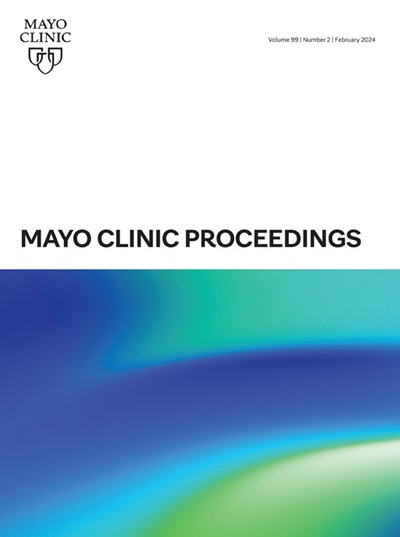明尼苏达州东南部社区未感染 COVID-19 的老年人群特征。
IF 6.7
2区 医学
Q1 MEDICINE, GENERAL & INTERNAL
引用次数: 0
摘要
目的评估有2019年冠状病毒病(COVID-19)感染史的参与者与无COVID-19感染史的参与者之间的人口统计学特征、公共卫生措施以及健康信念或行为的差异:一项基于横断面调查的研究嵌套在一项规模更大的前瞻性队列研究中,该研究以社区为基础,对 2511 名成人样本进行了调查,以评估病毒感染的发生率。研究纳入了居住在明尼苏达州东南部、年龄在 50 岁及以上、在 COVID-19 大流行初期至中期接受过评估并自述有 COVID-19 感染史的社区成人;有 1758 名参与者在 2021 年 6 月 6 日至 2022 年 2 月 7 日期间完成了调查。参与者被要求填写一份问卷,其中包含 42 个与 COVID-19 相关的项目。我们计算了COVID-19病史的比值比,以比较社会人口因素、当前和未来的健康行为以及健康信念,包括有效的预防措施和传播方式:我们发现,某些社会人口学特征和健康行为(如遵守公共卫生措施,如接种COVID-19疫苗)与预防COVID-19感染有关,而对有效的COVID-19保护措施和传播方式(如社会疏远类型)的强烈信念则将无COVID-19病史者与有COVID-19病史者区分开来:根据未来 COVID-19 变种的传播性、毒性和致病性,地方、州和联邦政府必须继续考虑公共卫生措施的风险和益处,并将这些保护因素考虑在内。本文章由计算机程序翻译,如有差异,请以英文原文为准。
Characteristics of an Older Adult Population Without COVID-19 Infection in a Southeast Minnesota Community
Objective
To assess demographic characteristics, public health measures, and health beliefs or behaviors that differentiate participants with a history of the coronavirus disease 2019 (COVID-19) infection from those with no history of COVID-19.
Methods
A cross-sectional survey-based study nested within a larger prospective cohort study of a community-based sample of 2511 adults was conducted to assess the incidence of viral infections. Community-based adults aged 50 years and older residing in southeast Minnesota who were assessed and self-reported history of COVID-19 infection during the early to mid phase of the COVID-19 pandemic were included; 1758 participants completed the survey between June 6, 2021, and February 7, 2022. Participants were asked to complete a questionnaire containing 42 items related to COVID-19. Odds ratios were calculated for history of COVID-19 to compare sociodemographic factors, current and future health behaviors, and health beliefs, including effective preventive measures and modes of transmission.
Results
We found that certain sociodemographic features and health behaviors (eg, adherence to public health measures, such as COVID-19 vaccination) are associated with protection against COVID-19 infection and that strong beliefs in effective COVID-19 protective measures and modes of transmission (eg, types of social distancing) differentiated those without from those with a history of COVID-19.
Conclusion
Depending on the communicability, virulence, and pathogenicity of future COVID-19 variants, local, state, and federal governments must continue to consider the risks and benefits of public health initiatives that take into consideration these protective factors.
求助全文
通过发布文献求助,成功后即可免费获取论文全文。
去求助
来源期刊

Mayo Clinic proceedings
医学-医学:内科
CiteScore
16.80
自引率
1.10%
发文量
383
审稿时长
37 days
期刊介绍:
Mayo Clinic Proceedings is a premier peer-reviewed clinical journal in general medicine. Sponsored by Mayo Clinic, it is one of the most widely read and highly cited scientific publications for physicians. Since 1926, Mayo Clinic Proceedings has continuously published articles that focus on clinical medicine and support the professional and educational needs of its readers. The journal welcomes submissions from authors worldwide and includes Nobel-prize-winning research in its content. With an Impact Factor of 8.9, Mayo Clinic Proceedings is ranked #20 out of 167 journals in the Medicine, General and Internal category, placing it in the top 12% of these journals. It invites manuscripts on clinical and laboratory medicine, health care policy and economics, medical education and ethics, and related topics.
 求助内容:
求助内容: 应助结果提醒方式:
应助结果提醒方式:


